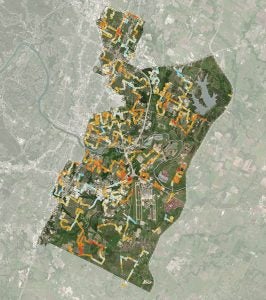UT Austin Teams Up With City and Community to Fight Extreme Heat in Austin
June 29, 2021

Austin has hot summers. But that heat isn’t felt the same way across the city, as anyone who has sweltered in a parking lot or cooled off beneath a tree knows.
The University of Texas at Austin is partnering with the City of Austin, community groups and East Austin residents to find out where hot temperatures are affecting people the most — and proposing solutions to cool down these places.
UT is one of four institutions selected by the National Oceanic and Atmospheric Administration to lead research projects focused on combating extreme heat in urban environments.

“This helps business and communities, and it is helping students to develop a purpose for their research,” said project lead Dev Niyogi, a professor at the UT Jackson School of Geosciences and the Cockrell School of Engineering. “They are not simply trying to develop an analysis or a plot. It’s a project where what we do means a better life for someone, if we do this right.”
The two-year project builds on an Austin heat map created by the CAPA Heat Watch program last year and has three main goals: creating dynamic heat maps that depict how people experience the heat alongside actual temperature measurements; using those maps to develop strategies to cool down temperature hot spots; and, finally, presenting the data and potential solutions to community members and city decision makers.
The project team includes researchers from UT’s School of Architecture, LBJ School of Public Affairs and UT Health Austin, along with geosciences and engineering researchers; the East Austin community health advocacy group Go Austin/Vamos Austin; and the City of Austin’s Office of Sustainability.
The project is part of UT’s Bridging Barriers initiative Planet Texas 2050, a cross-disciplinary research effort working to build more sustainable communities in Texas in the face of climate change and a booming population, and to share the benefit of its research with the world.
The temperature measurements will start in early July and will last through the summer.
The temperature map will include the entire city, but the project team will focus on collecting public input and making improvements in East Austin, where residents encounter hot spots more frequently.

Summer brings high temperatures across Texas. But cities tend to get even hotter because roofs, roads and other structures absorb more heat than land that is less developed. Thus, a person’s immediate surroundings can drastically change the temperature that person actually feels.
By using a combination of satellite data, on-the-ground sensors and computer models, the heat maps will be able to give a view of the temperature landscape that can go from all of Central Texas to a single street, with temperature readings ranging from every 1,000 square feet to every 3-10 square feet.
But measurements and models don’t give a full picture, and they can even clash with community experience. To make sure temperature readings and community experiences are aligned, the project team will incorporate resident input from the very beginning, engaging in discussions about temperature hot spots in their communities and receiving feedback on temperature maps.
“We can’t find out what the solutions are if we can’t connect,” said Marc Coudert, an environmental conservation program manager for the City of Austin and project team member.
There are a number of ways to reduce heat in specific areas, from adding greenery to installing light-colored pavement. To make sure any proposed solutions hold up over time, the researchers will investigate how potential improvements will affect local temperatures in coming decades.
The project is specifically tailored to help Austinites beat the heat. But people around the world may benefit from insights and data collected during the study, Niyogi said. To that end, in addition to presenting findings to the Austin City Council and other local decision makers, the researchers will be sharing what they learned with international colleagues through webinars and workshops.
For more information, contact: Anton Caputo, Jackson School of Geosciences, 512-232-9623; Monica Kortsha, Jackson School of Geosciences, 512-471-2241.
